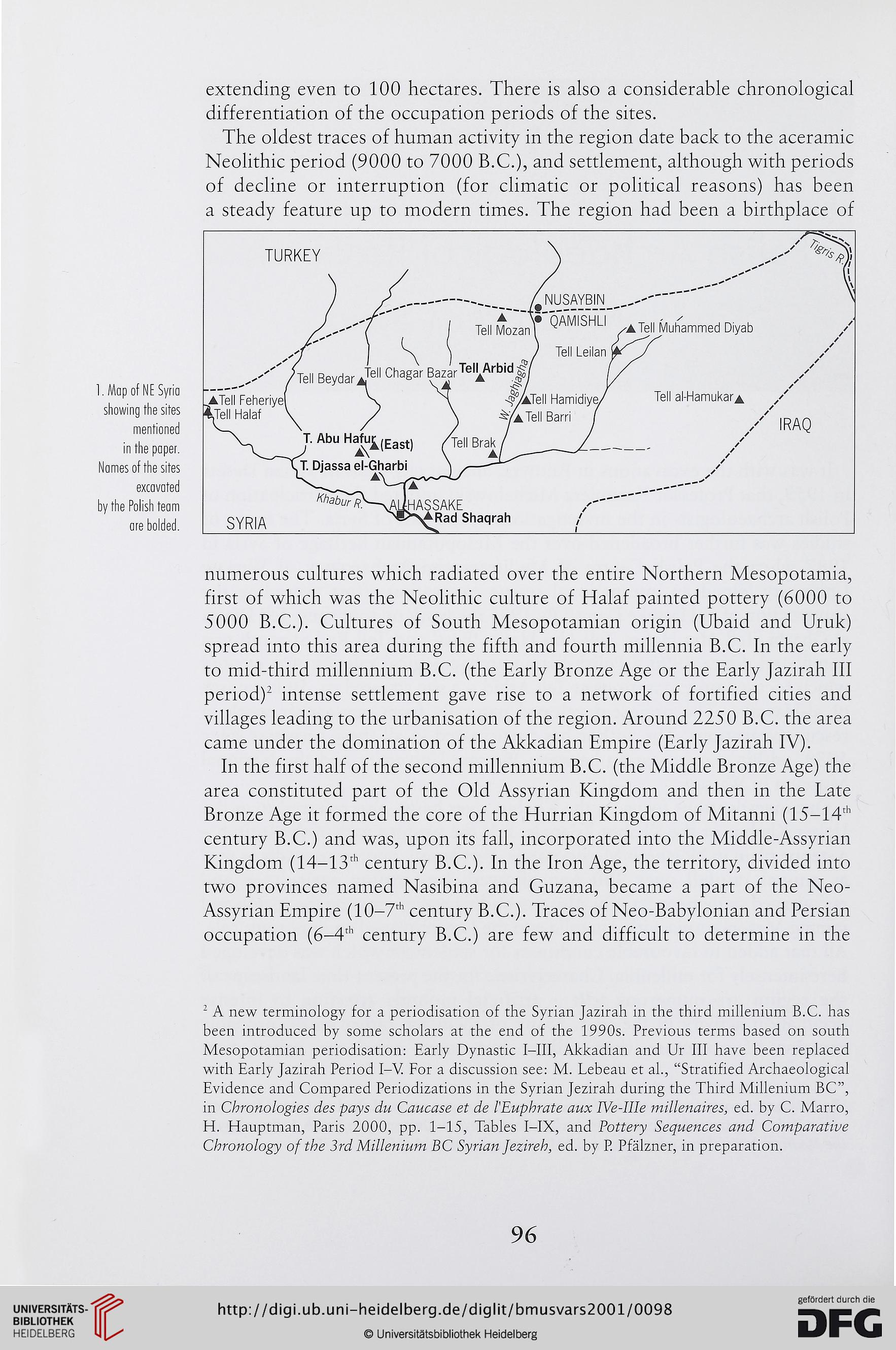1. Map of NE Syria
showing the sifes
mentioned
in the paper.
Names of the sites
excavated
by the Polish team
are bolded.
extending even to 100 hectares. There is also a considerable chronological
differentiation of the occupation periods of the sites.
The oldest traces of human activity in the region datę back to the aceramic
Neolithic period (9000 to 7000 B.C.), and settlement, although with periods
of decline or interruption (for climatic or political reasons) has been
a steady feature up to modern times. The region had been a birthplace of
numerous cultures which radiated over the entire Northern Mesopotamia,
first of which was the Neolithic culture of Halaf painted pottery (6000 to
5000 B.C.). Cultures of South Mesopotamian origin (Ubaid and Uruk)
spread into this area during the fifth and fourth millennia B.C. In the early
to mid-third millennium B.C. (the Early Bronze Age or the Early Jazirah III
period)2 intense settlement gave rise to a network of fortified cities and
villages leading to the urbanisation of the region. Around 2250 B.C. the area
came under the domination of the Akkadian Empire (Early Jazirah IV).
In the first half of the second millennium B.C. (the Middle Bronze Age) the
area constituted part of the Old Assyrian Kingdom and then in the Late
Bronze Age it formed the core of the Hurrian Kingdom of Mitanni (15—14th
century B.C.) and was, upon its fali, incorporated into the Middle-Assyrian
Kingdom (14—13th century B.C.). In the Iron Age, the territory, divided into
two provinces named Nasibina and Guzana, became a part of the Neo-
Assyrian Empire (10-7th century B.C.). Traces of Neo-Babylonian and Persian
occupation (6-4th century B.C.) are few and difficult to determine in the
2 A new terminology for a periodisation of the Syrian Jazirah in the third millenium B.C. has
been introduced by some scholars at the end of the 1990s. Previous terms based on south
Mesopotamian periodisation: Early Dynastie I-III, Akkadian and Ur III have been replaced
with Early Jazirah Period I-Y For a discussion see: M. Lebeau et al., “Stratified Archaeological
Evidence and Compared Periodizations in the Syrian Jezirah during the Third Millenium BC”,
in Chronologies des pays du Caucase et de l'Euphrate aux IVe-IIle millenaires, ed. by C. Marro,
H. Hauptman, Paris 2000, pp. 1-15, Tables I-IX, and Pottery Seąuences and Comparatwe
Chronology of the 3rd Millenium BC Syrian Jezireh, ed. by P. Pfalzner, in preparation.
96
showing the sifes
mentioned
in the paper.
Names of the sites
excavated
by the Polish team
are bolded.
extending even to 100 hectares. There is also a considerable chronological
differentiation of the occupation periods of the sites.
The oldest traces of human activity in the region datę back to the aceramic
Neolithic period (9000 to 7000 B.C.), and settlement, although with periods
of decline or interruption (for climatic or political reasons) has been
a steady feature up to modern times. The region had been a birthplace of
numerous cultures which radiated over the entire Northern Mesopotamia,
first of which was the Neolithic culture of Halaf painted pottery (6000 to
5000 B.C.). Cultures of South Mesopotamian origin (Ubaid and Uruk)
spread into this area during the fifth and fourth millennia B.C. In the early
to mid-third millennium B.C. (the Early Bronze Age or the Early Jazirah III
period)2 intense settlement gave rise to a network of fortified cities and
villages leading to the urbanisation of the region. Around 2250 B.C. the area
came under the domination of the Akkadian Empire (Early Jazirah IV).
In the first half of the second millennium B.C. (the Middle Bronze Age) the
area constituted part of the Old Assyrian Kingdom and then in the Late
Bronze Age it formed the core of the Hurrian Kingdom of Mitanni (15—14th
century B.C.) and was, upon its fali, incorporated into the Middle-Assyrian
Kingdom (14—13th century B.C.). In the Iron Age, the territory, divided into
two provinces named Nasibina and Guzana, became a part of the Neo-
Assyrian Empire (10-7th century B.C.). Traces of Neo-Babylonian and Persian
occupation (6-4th century B.C.) are few and difficult to determine in the
2 A new terminology for a periodisation of the Syrian Jazirah in the third millenium B.C. has
been introduced by some scholars at the end of the 1990s. Previous terms based on south
Mesopotamian periodisation: Early Dynastie I-III, Akkadian and Ur III have been replaced
with Early Jazirah Period I-Y For a discussion see: M. Lebeau et al., “Stratified Archaeological
Evidence and Compared Periodizations in the Syrian Jezirah during the Third Millenium BC”,
in Chronologies des pays du Caucase et de l'Euphrate aux IVe-IIle millenaires, ed. by C. Marro,
H. Hauptman, Paris 2000, pp. 1-15, Tables I-IX, and Pottery Seąuences and Comparatwe
Chronology of the 3rd Millenium BC Syrian Jezireh, ed. by P. Pfalzner, in preparation.
96




